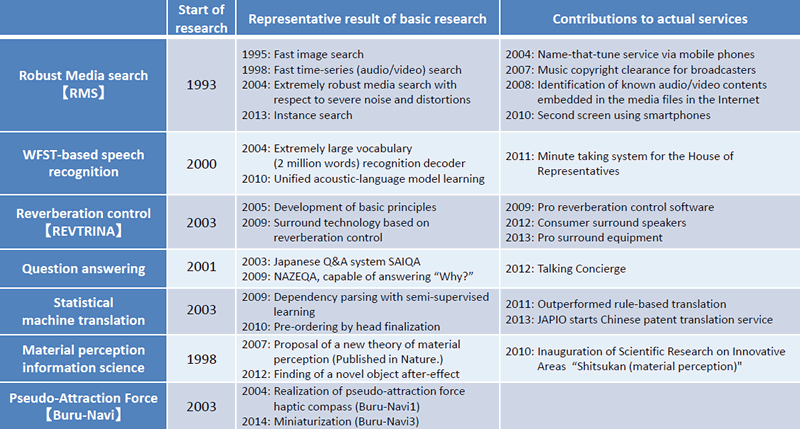
Director's Talk
Thursday, June 5 13:00-13:30
Basic research - Defining our age and the future
- The origin of ideas and the seeds of innovation -
Eisaku Maeda, Director, NTT Communication Science Laboratories
Photos
Abstract
It has been 23 years since NTT Communication Science Laboratories (NTT CSL) were established, and 14 years since we began basic research under the new system instituted by the reorganization of NTT. During this time NTT CSL have established a sure framework that have led to the gradual adoption of our technologies, born from basic research, around the world. I believe that we are now at a major turning point for our next step.
The mission of basic research is to tackle difficult problems without the fear of risks. Because of this, it is difficult for researchers to predict when a problem will be solved. Most recently, we developed Buru-Navi3, the newest version of our haptic compass. This device makes use of human’s sensory properties to induce a pseudo-attraction force. It has long been thought that miniaturizing a haptic compass while maintaining the pseudo-attraction force would be difficult. However, this problem was suddenly resolved one day. Haptic compasses, developed ten years ago, can now be made at 1/20 its previous size.
Figure 1: Basic research from seed to fruit
The enterprise of basic research is certainly not a special undertaking far from the real world. It is something tied to the times and should exist together with the times. John R. Pierce, a bedrock figure of Bell Labs, said that not only are outstanding concepts and planning essential to innovations, but also above all timing is crucial. The time of the market introduction of a new product determines its success or failure [1, 2]. Besides existing with the times in the selection of problems to tackle, basic research also requires that we contribute to entering the market based on a sense of urgency for our time period. More than ever, we are devoting our energy to creating new, innovative technologies as we focus our sights on the demands of our times.
Table 1: Examples of NTT CSL’s achievements
(start of research, solutions to problems, completion of technology, and realization of service)
The “Invisible” Innovations of Information Technology
Compared with mechanical technologies such as the steam engine and letterpress printing, which are definitive examples of technological innovations, information technology occupies a slightly special position. When you point out a product or service to someone, he or she is able to say that innovation has taken place. However, experts lament that although information technology is also being used today, its importance is not being conveyed to the common person. This demonstrates that information technology’s innovations are “invisible.” Meanwhile, when information technology is directly connected to products and services, or even if it is not directly reflected in them, amazing technological innovations occur once every several years in the different areas of information technology. However, only a fraction of the experts in these fields realize this. Again, we see that the innovations of information technology are “invisible.” There can be no doubt, therefore, that the fruits of basic research that we will introduce at the Open House contain many hidden seeds of innovations that no one yet foresees.Planting fruit-yielding trees, and evolving them through succeeding generations
The enterprise of basic research is summarized in Figure 1. The transformation of trivial ideas and the discovery of problems lead to the seeds of research. The seeds sprout a while after they are sown and watered. Furthermore, when fertilizer and sunlight are provided, flowers bloom in the form of journal articles and patents. Before long, flowers become fruits and can be harvested. This process (Phase 1), from sowing seeds to cultivating trees to picking fruits, is the most important process that constitutes the foundation of basic research. It leads to further evolution of technology as a variety of seeds are stored, and at the same time, new seeds are collected from fruits and once again sown.The mission of basic research is to tackle difficult problems without the fear of risks. Because of this, it is difficult for researchers to predict when a problem will be solved. Most recently, we developed Buru-Navi3, the newest version of our haptic compass. This device makes use of human’s sensory properties to induce a pseudo-attraction force. It has long been thought that miniaturizing a haptic compass while maintaining the pseudo-attraction force would be difficult. However, this problem was suddenly resolved one day. Haptic compasses, developed ten years ago, can now be made at 1/20 its previous size.

Figure 1: Basic research from seed to fruit
Basic research exists with the times
Just as fruits nourish us when we eat them, so the fruits of research also have value in their use as technologies. The fruits of NTT CSL’s basic research continue to give rise to technologies that enter into the real world. Representative examples are shown in Table 1. When we analyze these examples, we see that in many cases about ten years are required from the time the seeds are planted. Furthermore, the time from bearing fruits to their being served on the dining table (Phase 2) is varied. There have been cases where even when a technology had been completed, it was not utilized because it did not meet the needs of the time. It is often difficult to predict when the time will come to make use of an available technology. We must maintain and protect a technology pool where such technologies are stored. At the same time, we must also prepare a system that enables a technology to be immediately launched into the world when the right time arrives. Furthermore, the entire NTT Laboratories are strengthening efforts to create new markets (Phase 3) by collaborating and co-innovating with other industries.The enterprise of basic research is certainly not a special undertaking far from the real world. It is something tied to the times and should exist together with the times. John R. Pierce, a bedrock figure of Bell Labs, said that not only are outstanding concepts and planning essential to innovations, but also above all timing is crucial. The time of the market introduction of a new product determines its success or failure [1, 2]. Besides existing with the times in the selection of problems to tackle, basic research also requires that we contribute to entering the market based on a sense of urgency for our time period. More than ever, we are devoting our energy to creating new, innovative technologies as we focus our sights on the demands of our times.

Table 1: Examples of NTT CSL’s achievements
(start of research, solutions to problems, completion of technology, and realization of service)
-
[Related literature]
- [1] Jon Gertner, The Idea Factory: Bell Labs and the Great Age of American Innovation, Penguin Books, Reprint 2013.
- [2] Fred Vogelstein, Dogfight: How Apple and Google Went to War and Started a Revolution, William Collins, 2013.
Speaker

Director, NTT Communication Science Laboratories
Eisaku Maeda


